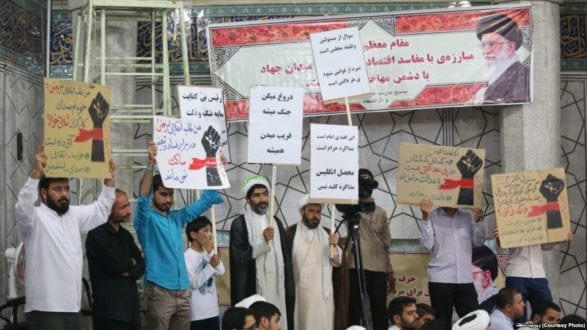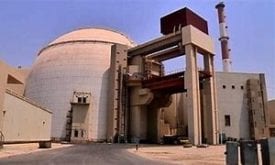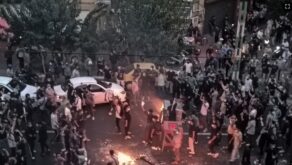radiofarda – A protest rally against “financial corruption” held Thursday, August 16, at Iran’s major Shi’ite seminary in city of Qom, turned into a demonstration against President Hassan Rouhani.
Shi’ite seminarians who receive stipends from the office of the Islamic Republic’s Supreme Leader, Ayatollah Ali Khamenei and other conservative top clergy chanted threatening slogans aimed directly at Rouhani.
A news agency affiliated with the Islamic Revolution Guards Corps (IRGC), Tasnim, reported, the rally was held under the banner of “Demanding Economic Justice” and its participants barraged the government with bitter criticism, calling for the “punishment” of unidentified individuals accused of “financial and economic corruption”.
Shafaqna, a website that covers stories related to the Qom seminary, has published pictures of the gathering, including images that show the chief commander of clergy scholars’ brigade, “Imam Sadiq Brigade”, Hossein Tayyebifar and a member of the Cultural Revolution Supreme Council, Hassan Rahimpoor Azghadi, addressing the crowd.
The images published by Shafaqna also show the seminarians carrying banners and posters directly condemning president Rouhani and his foreign policy.
Referring to the Joint Comprehensive Plan of Action (JCPOA) or Iran’s nuclear deal with world powers in 2015, as well as the U.S. decision last May to withdraw from the agreement, some of the posters read, “Six years of negotiation led to nowhere”, “Oh supporters of JCPOA, return and obey the Leader” and the “Epitomes of corruption must be crushed”.
Meanwhile, one of the posters implicitly threatened Rouhani with the fate of his mentor and ex-president, Akbar Hashemi Rafsanjani who died in suspicious circumstances, while swimming in a pool on January 8, 2017.
Iran’s economy, which hardly had any bright spots, has been deteriorating further in recent months, as president Trump’s inclination to leave the nuclear agreement became apparent.
Nationwide protests broke out last December and soon spread to more than 0ne hundred cities across the country.
The protests that were primarily focused on skyrocketing prices, unemployment and economic hardship, soon turned into enraged anti-establishment revolt.
Intermittent protests have continued since then and the Iranian regime finds itself in a tight spot, with U.S. sanctions being reimposed.
The steep devaluation of the national currency has made matters worse for the regime, as it has significantly cut into the purchasing power of ordinary Iranians.
In recent weeks, ayatollah Khamenei and his hardliner followers have been increasingly putting the blame for the economic hardship on Rouhani.
The Qom protest may be seen in this context.
 Shabtabnews In this dark night, I have lost my way – Arise from a corner, oh you the star of guidance.
Shabtabnews In this dark night, I have lost my way – Arise from a corner, oh you the star of guidance.



